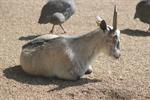 Trees are cut to provide fodder for animals in many parts of the world; in some places routinely, and in other places only occasionally when needed (e.g. during drought).
Trees are cut to provide fodder for animals in many parts of the world; in some places routinely, and in other places only occasionally when needed (e.g. during drought).
WARNING: Be careful about what tree species are used for fodder. A third of all plant species (or more), contain toxic chemicals that may be detrimental, or even deadly to animals that eat them. Grazing animals may normally keep away from toxic plants but that is not always the case, and in situations where an animal is stressed, it may eat things it might not normally eat.
The following are just some examples of fodder trees which may or may not naturally be distributed in your locality.
- Acacia (Wattle) -Some types of wattle are used as stock food at times, but not all species.
- Willow (Salix species) can be eaten by cattle.
- Tree Lucerne or Tagasaste Foliage and pods edible. Needs well drained soil. Developing seed pods should be eaten to reduce the spread of this plant by seed
- Leucaena foliage and seed pods are edible. For tropical summer rainfall areas. Most varieties contain mimosine which may cause problems if animals eat too much Leucaena.
- Honey Locust has edible seed pods suited to most of Eastern Australia, may need summer irrigation.
- Carob has edible pods produced on a good shade tree. For hot, dry country.
- Casuarina and Allocasuarina (She Oak) An excellent windbreak tree with edible foliage.
- Paulownia has edible leaves. The tree requires good soils and usually. Needs irrigation to get established.
- Bamboo Some types of bamboo can contain 10-20% crude protein, and are sometimes used as fodder for horses and other animals.
There are many more plants that can be used. Once the plants are well established (two to three years), horses can be allowed into the fenced area to browse. They may need to learn to eat the trees, or if left too long, they may strip the bark off (ringbarking) which kills the trees. Alternatively branches can be lopped off and fed to the grazing animals.
Fodder trees are often a good choice for planting on a farm or any property supporting livestock; particularly on a larger property where there may be occasions where animals require supplementary feeding (e.g. in times of drought).
The quality of fodder depends upon the relative amounts of different components in the food. Usefulness may be low or nil if the plant tissues contain significant toxins or other negative components such as tannings, oils or salt.
Dry grass is not as digestible for grazing animals as green grass, because when dry, it is high in cellulose and lignin, and low in sugars and protein.
Anything that is higher in sugar and protein may be used as a supplement to grazing on grass when a paddock is dry (e.g. Pods from Carob, Honey Locust and Tree Lucerne).